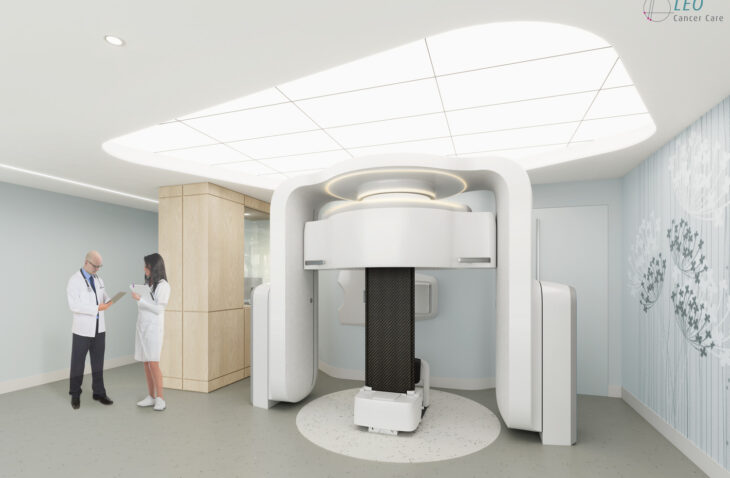New Cancer Center with Proton Therapy

The project: The Carbone Cancer Center is part of the new UW Health Eastpark Medical Center. The two-story cancer center will be the first facility in Wisconsin to offer horizontal, rotating gantry proton therapy and one of the first in the U.S. to offer upright proton therapy—a fixed-beam system in which the patient sits up. The upright system offers improved accuracy, greater comfort, and reduced patient anxiety.
Engineering approach: IMEG worked collaboratively with the architect, UW Health project managers, contractor, and trades to meet the design criteria of the systems required to support state-of-the-art proton therapy and make accommodations for radiation concerns. For example, ductwork and piping had to be routed through maze-type corridors used to access treatment and accelerator rooms, and penetrations through extra-thick concrete walls had to be installed at 45-degree angles. Ductwork and piping also could not be routed over any equipment and only a minimal number of systems could be routed below the gantry’s removable roof system.
MEP design: Mechanical features include large capacity process water cooling and air conditioning systems for the extreme heat gain from the process equipment. Over 190 tons of deionized process chilled water capacity also is provided, and a 2.5 CFM/ sq. ft. AHU serving treatment, gantry, and accelerator rooms is augmented by heat rejection to the process chilled water system.
Large exhaust airflows and associated duct sizes were provided for the gantry, accelerator, and treatment rooms to remove potential radiation particles from high-supply airflows; supply and exhaust air to these rooms is measured for pressurization control. High-capacity cooling and heating water coils and gas-fired humidifiers were also provided for these rooms due to the spaces’ high exhaust flow rates.
Process water needs required two process water loops, one for the accelerator and the other for magnets, power supplies, and other equipment. In addition, two cooling sources utilize heat exchangers—a building chilled water system and domestic water for backup. Deionized water for chilled water and deionized water processors maintain water purity, which is continually monitored.
Remote sensors were provided for electronic equipment that could not be in the gantry and accelerator rooms due to radiation.
Plumbing design accommodated for a high water table that threatened the building and expensive proton therapy equipment. Two independent drain tile systems were placed just above the water table and below the larger of two gantry pit floors. A high performance water proofing system was applied to the foundation walls; a triplex sump pump system was installed; and a second duplex sump pump system in the lowest pit will allow for drainage of water from spills and leaks. Other plumbing features include:
- Ultra-pure, low dew point, compressed air, stainless steel compressed air piping, and continuous air quality monitoring.
- Coated CI no hub sanitary and vent piping with joint restraint and plastic wrapped fittings in concrete walls and floors that were 7 feet thick or more (PVC piping was not used due to exothermic heat produced during concrete curing).
- A double interlock preaction sprinkler system that minimizes damage risk to electronic equipment.
Electrical features include dedicated 480/277-volt service entrance for noise interference isolation and voltage regulation; 480/277-volt 225-amp transfer switch supplied from optional standby power; 100kVA UPS for proton equipment; and proton therapy interface signals to building systems with a programmable logic controller.
Outcome: The Carbone Cancer Center will bring state-of-the-art proton therapy to patients who currently must travel out of state for such treatment. The proton center also will be powered by a nearby 1MW rooftop solar array, making it carbon-free.







